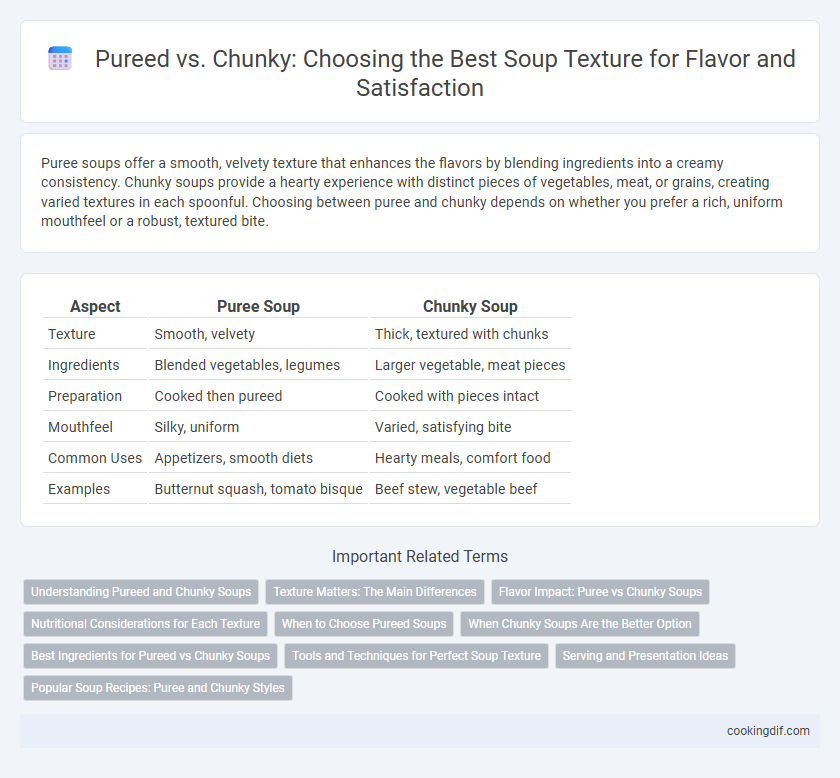Puree soups offer a smooth, velvety texture that enhances the flavors by blending ingredients into a creamy consistency. Chunky soups provide a hearty experience with distinct pieces of vegetables, meat, or grains, creating varied textures in each spoonful. Choosing between puree and chunky depends on whether you prefer a rich, uniform mouthfeel or a robust, textured bite.
Table of Comparison
| Aspect | Puree Soup | Chunky Soup |
|---|---|---|
| Texture | Smooth, velvety | Thick, textured with chunks |
| Ingredients | Blended vegetables, legumes | Larger vegetable, meat pieces |
| Preparation | Cooked then pureed | Cooked with pieces intact |
| Mouthfeel | Silky, uniform | Varied, satisfying bite |
| Common Uses | Appetizers, smooth diets | Hearty meals, comfort food |
| Examples | Butternut squash, tomato bisque | Beef stew, vegetable beef |
Understanding Pureed and Chunky Soups
Pureed soups offer a smooth, velvety texture achieved by blending ingredients until fully liquefied, enhancing flavor integration and creaminess. Chunky soups retain distinct pieces of vegetables, meats, or legumes, providing a hearty, textured bite that emphasizes the freshness of individual components. Understanding the differences helps in selecting the desired mouthfeel and presentation, depending on the culinary goal and ingredient profiles.
Texture Matters: The Main Differences
Puree soup boasts a smooth, velvety texture achieved by blending ingredients until completely uniform, enhancing creaminess and mouthfeel. Chunky soup offers varied texture with distinct pieces of vegetables, meat, or legumes, providing a more substantial, hearty eating experience. Texture matters as puree suits delicate palates and blends flavors seamlessly, while chunky soups deliver satisfying bites and diverse textures.
Flavor Impact: Puree vs Chunky Soups
Puree soups create a smooth, velvety texture that intensifies flavors by blending all ingredients uniformly, enhancing the natural taste of vegetables and spices. Chunky soups maintain distinct pieces of vegetables, meat, or legumes, offering varied texture and bursts of concentrated flavor with each bite. Choosing between puree and chunky soups depends on whether a consistent flavor profile or a contrasting, dynamic taste experience is desired.
Nutritional Considerations for Each Texture
Puree soups provide easier digestion and higher bioavailability of nutrients due to their smooth, blended consistency, making them ideal for individuals with swallowing difficulties or sensitive digestion. Chunky soups retain more fiber and intact vegetables, supporting digestive health and promoting satiety through slower nutrient absorption. Both textures offer distinct nutritional benefits, with purees favoring nutrient absorption and chunkier options enhancing fiber intake and chewing stimulation.
When to Choose Pureed Soups
Pureed soups deliver a smooth, velvety texture ideal for blending flavors uniformly, making them perfect for meals requiring easy digestion or elegant presentation. These soups often incorporate vegetables like butternut squash, carrots, or tomatoes, transformed into creamy consistency using blenders or food processors. Choose pureed soups when catering to dietary needs, enhancing nutrient absorption, or seeking a comforting, warm dish with a rich mouthfeel.
When Chunky Soups Are the Better Option
Chunky soups are the better option when a heartier, more satisfying meal is desired due to their substantial texture and variety of ingredients, such as vegetables, meat, and grains. These soups provide a diverse mouthfeel and complex flavors, making them ideal for colder weather or as a standalone dish. Chunky soups also retain more nutrients and fiber compared to pureed options because the ingredients remain intact.
Best Ingredients for Pureed vs Chunky Soups
Pureed soups benefit from smooth, starchy vegetables like potatoes, pumpkins, and carrots, which create a creamy texture when blended. Chunky soups thrive with hearty ingredients such as diced tomatoes, beans, and tender meats that maintain their structure during cooking. Using fresh herbs and spices enhances both types, with pureed soups favoring blended seasonings and chunky soups benefiting from whole leaves or cracked peppercorns for added texture.
Tools and Techniques for Perfect Soup Texture
Achieving the ideal soup texture depends on selecting the right tools and techniques: blenders and food processors create smooth, velvety purees, while immersion blenders offer control for slightly chunkier textures without over-processing. Mechanical methods like mashing with a fork or potato masher allow for rustic, chunky textures by breaking ingredients down manually, preserving some bite. Understanding the soup's ingredients and desired consistency guides the choice between pureeing for smoothness or blending for a hearty, textured finish.
Serving and Presentation Ideas
Puree soups offer a smooth, velvety texture ideal for elegant presentation in clear glass bowls or white porcelain cups, often garnished with a swirl of cream, fresh herbs, or a drizzle of olive oil to enhance visual appeal. Chunky soups provide a hearty, rustic look that pairs well with rustic bread bowls or deep ceramic mugs, allowing the vibrant colors and varied textures of vegetables, meat, and legumes to create an inviting, comforting experience. For serving, consider clear portion sizes and complementary side dishes to balance the texture and enrich overall presentation.
Popular Soup Recipes: Puree and Chunky Styles
Puree soups offer a smooth and creamy texture, commonly found in recipes like butternut squash soup and tomato bisque, making them ideal for a velvety mouthfeel. Chunky soups such as minestrone and chicken vegetable feature distinct pieces of meat, vegetables, and beans, providing a hearty and satisfying bite with complex flavors. Popular soup recipes often reflect these textures to cater to diverse preferences, balancing nutritional content and culinary experience.
Puree vs Chunky for soup texture Infographic

 cookingdif.com
cookingdif.com